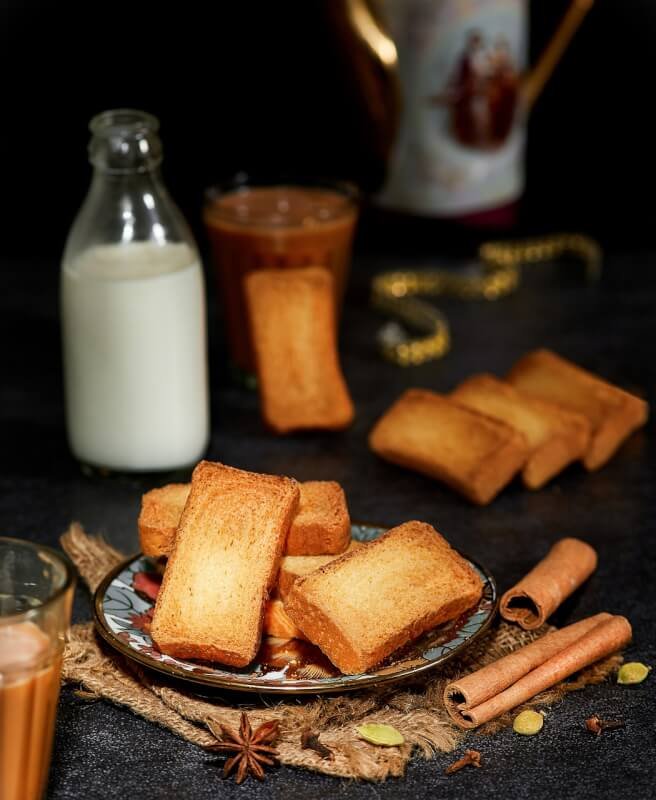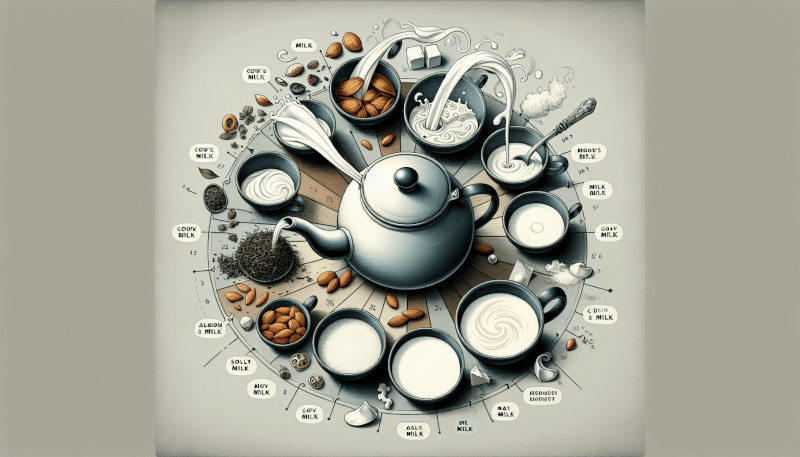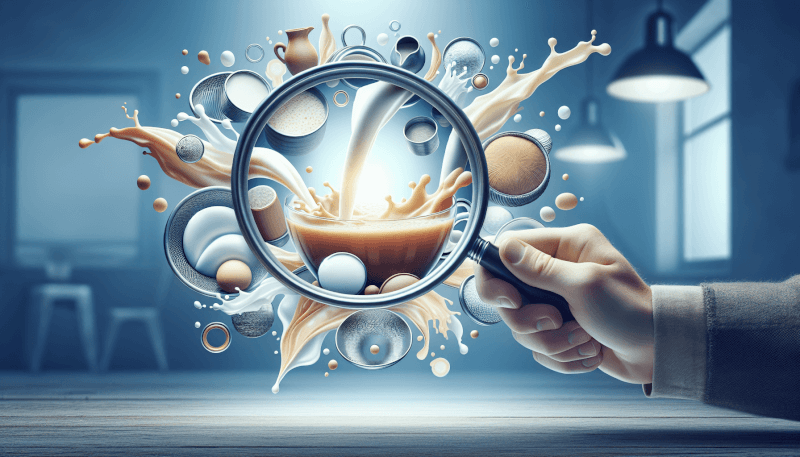When it comes to enjoying a cup of tea, there is an art to perfecting it with the right choice of milk and cream. From the smooth creaminess of whole milk to the richness of heavy cream, each option adds a unique flavor and texture to your tea. Whether you prefer a strong black tea with a splash of creamy almond milk or a delicate green tea with a dollop of sweetened condensed milk, exploring the world of milk and cream options can elevate your tea-drinking experience to new heights. In this article, we will uncover the secrets to creating the perfect cup of tea with various milk and cream choices, ensuring that each sip is an indulgent treat.

Choosing the Right Tea
Understanding the Different Tea Types
When it comes to choosing the right tea, it’s important to have a good understanding of the different types available. Tea is typically categorized into four main types: green tea, black tea, oolong tea, and herbal tea.
Green tea is known for its refreshing and grassy flavor. It is often praised for its antioxidant properties and health benefits. Black tea, on the other hand, has a fuller and stronger flavor. It is the most popular type of tea worldwide and is often enjoyed with milk and sugar.
Oolong tea is a semi-oxidized tea with a wide range of flavors, from light and floral to rich and fruity. Finally, herbal tea is not technically tea as it doesn’t come from the Camellia sinensis plant, but it is often referred to as such. It is a caffeine-free option that comes in a variety of flavors, such as chamomile, peppermint, and hibiscus.
Factors to Consider when Choosing Tea
When choosing tea, there are several factors to consider. First and foremost, think about your personal preference for flavor. Do you prefer a lighter, more delicate taste, or do you enjoy the robustness of a strong brew?
Another factor to consider is the health benefits associated with different tea types. Green tea, for example, is known for its antioxidant properties and can help boost the metabolism. Black tea, on the other hand, is often consumed for its potential heart health benefits.
Additionally, think about the occasion and the time of day you will be enjoying your tea. For a refreshing pick-me-up in the morning, a cup of black tea with milk might be the perfect choice. In the evening, however, you might prefer a soothing cup of herbal tea.
Milk and Cream Varieties
Dairy Milk Options
When adding milk to your tea, you have several dairy options to choose from. The most common choice is cow’s milk, which adds richness and creaminess to your tea. Whole milk, with its higher fat content, will lend a richer flavor compared to skim or low-fat milk.
If you’re looking for a lighter alternative, you can try using goat’s milk or sheep’s milk. These milks have a distinct flavor that can add a unique twist to your tea.
Non-Dairy Milk Alternatives
For those who cannot or prefer not to consume dairy, there are plenty of non-dairy milk alternatives available. One popular option is almond milk, which has a slightly nutty flavor. Oat milk, made from oats, has a creamy texture and a mild taste that complements tea well. Soy milk and coconut milk are also commonly used alternatives.
It’s worth noting that each non-dairy milk alternative has its own unique flavor profile, so it’s best to experiment and find the one that you enjoy the most with your tea.
Cream Options
If you prefer a richer and creamier texture in your tea, you can opt for different cream varieties. Heavy cream, also known as whipping cream, has a high fat content and will lend a luxurious mouthfeel to your tea. Half-and-half, a combination of equal parts milk and cream, offers a balance between richness and lighter texture.
For a non-dairy cream alternative, you can try using coconut cream or cashew cream. These options provide a creamy texture without the use of dairy products.
Brew Time and Temperature
Ideal Brew Time for Different Tea Types
The ideal brew time for tea can vary depending on the type of tea you are using. Green tea, for example, is best brewed for approximately 2-3 minutes. This shorter brewing time helps to prevent the tea from becoming bitter.
Black tea, on the other hand, benefits from a longer brew time of around 4-5 minutes. This allows the flavors to fully develop, resulting in a more robust and flavorful cup of tea.
Oolong tea falls somewhere in between, typically requiring a brew time of 3-4 minutes. Herbal teas, being caffeine-free, can be steeped for a little longer, around 5-7 minutes, to extract their full flavors.
Optimal Water Temperature for Brewing Tea
In addition to the brew time, it’s important to pay attention to the water temperature when brewing tea. Different teas require different water temperatures to bring out their best flavors.
Generally, green teas are best brewed with water that is around 175°F (80°C). Black teas, on the other hand, benefit from hotter water, around 200°F (93°C). Oolong teas typically require water between 185°F (85°C) and 205°F (96°C) for optimal brewing.
Herbal teas are more forgiving and can be brewed with boiling water, which is around 212°F (100°C). This higher temperature helps to draw out the flavors and aromas of the herbs and botanicals.
Brewing Methods
Traditional Brewing Methods
When it comes to brewing tea, there are several traditional methods that have been used for centuries. One popular method is the use of a teapot or teacup infuser. This allows the tea leaves to steep and infuse into the water, creating a flavorful cup of tea.
Another traditional brewing method is the use of a tea strainer or a tea ball. This is especially useful when using loose leaf tea, as it prevents the leaves from ending up in your cup.
Modern Brewing Methods
In recent years, modern brewing methods have gained popularity, offering convenience and efficiency. One such method is the use of tea bags, which contain pre-packaged portions of tea leaves. This eliminates the need for a separate infuser or strainer, making it a convenient option for everyday use.
Another modern brewing method is the use of single-serve machines, such as pod systems or automatic tea makers. These machines simplify the brewing process and offer a wide variety of tea options at the touch of a button.

Pairing Tea with Milk and Cream
Best Tea and Milk Combinations
Certain teas are particularly well-suited for pairing with milk, creating a delightful and harmonious flavor combination. Black teas, such as Earl Grey and English Breakfast, are classic choices that pair beautifully with milk. The creamy texture of the milk helps to balance out the robustness of the tea.
Assam tea, with its malty and bold flavor, is another great candidate for pairing with milk. The sweetness of the milk complements the tea’s strong and rich taste.
Green teas, on the other hand, are typically enjoyed without milk, as their delicate flavors can be easily overwhelmed. However, if you prefer a milder cup, you can experiment with adding a splash of milk to green tea as well.
Flavor Profiles and Intensity
When pairing tea with milk or cream, it’s also important to consider the flavor profiles and intensity of both the tea and the dairy product. A delicate white tea, for example, may be overwhelmed by a heavy cream, while a strong black tea may require a richer milk or cream to balance out its robust flavors.
Experimenting with different combinations is the key to finding your perfect cup. Start with small amounts of milk or cream and gradually adjust to your taste preferences.
Making a Basic Cup of Tea with Milk or Cream
Step-by-Step Guide to Brewing Tea with Milk or Cream
Brewing tea with milk or cream is a simple process that requires just a few steps. Here is a step-by-step guide to help you make a basic cup of tea with milk or cream:
- Start by selecting your preferred tea and the type of milk or cream you would like to use.
- Heat water to the appropriate temperature for your chosen tea type.
- Place the tea leaves or tea bag in a teapot or directly into your cup if using a teacup infuser.
- Pour the hot water over the tea leaves and let it steep for the recommended brew time.
- Once the tea has brewed, remove the tea leaves or tea bag from the teapot or teacup.
- Add milk or cream to your taste, starting with a small amount and adjusting as needed.
- Stir the tea gently to combine the flavors.
- Enjoy your cup of tea with milk or cream!
Remember, these instructions are a guideline, and you can adjust the proportions of tea, milk, and cream according to your personal preference.

Enhancing Tea with Milk and Cream
Adding Milk or Cream at Different Stages of Brewing
For a more nuanced flavor profile, you can experiment with adding milk or cream at different stages of the brewing process. Some tea connoisseurs prefer to add milk or cream before pouring the hot water over the tea leaves, allowing the flavors to meld together from the beginning.
Others prefer to steep the tea first and then add milk or cream after the brewing process, allowing the flavors to develop separately. Both methods can yield unique and enjoyable results, so don’t be afraid to try both to find your preferred technique.
Frothing Milk for Lattes and Cappuccinos
If you enjoy frothy and creamy tea drinks such as lattes or cappuccinos, you can easily achieve this by frothing your choice of milk or cream. Using a milk frother or a steam wand on an espresso machine, you can create a velvety foam that adds a luxurious touch to your tea.
To froth milk, heat it gently and then use the frother or steam wand to create the desired foam consistency. Pour the frothed milk over your brewed tea and enjoy the creamy delight.
Seasonal Tea Creations
Winter Warmers with Milk and Cream
During the winter months, tea can bring warmth and comfort, especially when paired with milk or cream. Traditional favorites like chai tea, spiced with ingredients like cinnamon, cardamom, and ginger, are perfect for cozy winter evenings.
For a festive twist, you can create a peppermint hot chocolate tea by combining black tea, cocoa powder, peppermint extract, and milk or cream. This delightful winter beverage is sure to bring joy and warmth to your chilly days.
Iced Tea Delights with Milk and Cream
For those warm summer days, cold and refreshing iced tea can be enhanced with the addition of milk or cream. A classic favorite is Thai Iced Tea, a combination of black tea, condensed milk, and spices like star anise and cloves. The result is a creamy and sweet iced tea that is perfect for beating the heat.
You can also experiment with creating your own iced tea latte by brewing a strong tea of your choice, letting it cool, and then pouring it over ice with milk or cream. Add a touch of sweetness with a drizzle of honey or flavored syrup for a truly delightful summer beverage.
Exploring Tea Latte Recipes
Classic Tea Latte Recipes
Tea lattes are a popular choice for those looking for a creamy and indulgent tea experience. One classic tea latte is the London Fog, which combines Earl Grey tea, steamed milk, and a hint of vanilla syrup. The result is a fragrant and comforting beverage that is perfect for rainy days.
Chai tea lattes are another beloved choice. Combining black tea, traditional Indian spices, steamed milk, and a touch of sweetness, this spicy and aromatic drink is sure to awaken your senses.
Creative Tea Latte Variations
If you’re feeling adventurous, there are countless creative variations to explore when it comes to tea lattes. Matcha lattes, made with vibrant green tea powder and steamed milk, have become increasingly popular due to their vibrant color and energizing properties.
For a floral twist, you can try a lavender rose latte by infusing milk with dried lavender and adding a dash of rose syrup to your tea. The result is a delicate and fragrant latte that is both visually stunning and delicious.
Tea Etiquette and Traditions
Tea-Related Customs from Around the World
Tea has a rich history and a variety of customs and traditions associated with it. In Japan, for example, the tea ceremony is a highly ritualized practice that emphasizes harmony, respect, and tranquility. Tea is prepared and served with meticulous attention to detail, making it an art form in itself.
In England, afternoon tea is a cherished tradition that involves a selection of teas paired with an assortment of finger sandwiches, scones, and delicate pastries. This elegant affair is often enjoyed in the afternoon as a way to take a break from the day and indulge in some relaxation.
Proper Etiquette for Serving Tea with Milk or Cream
When it comes to serving tea with milk or cream, there are a few etiquette guidelines to keep in mind. In British tea traditions, milk is usually added after the tea has been poured into the cup. This allows each individual to add the desired amount of milk according to their taste.
If you are serving tea to guests, it is polite to ask if they prefer their tea with milk or without. Some people may have specific preferences or dietary restrictions that should be respected.
Ultimately, the most important thing is to enjoy your cup of tea with milk or cream in a way that brings you pleasure. Whether you’re savoring the classic combination of black tea and dairy milk or exploring the world of non-dairy alternatives, the art of brewing tea with milk and cream offers endless possibilities to suit your taste and preferences.

